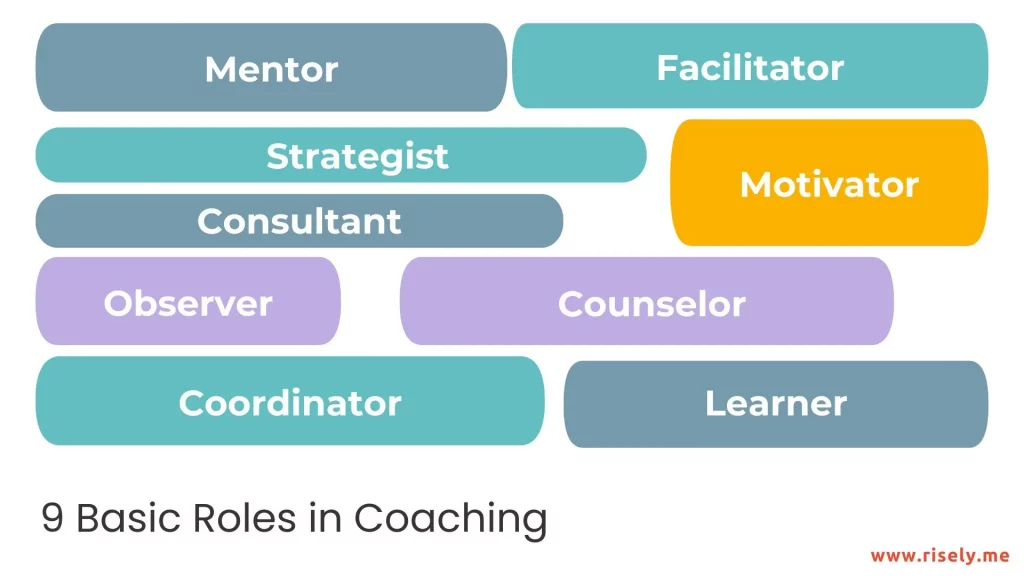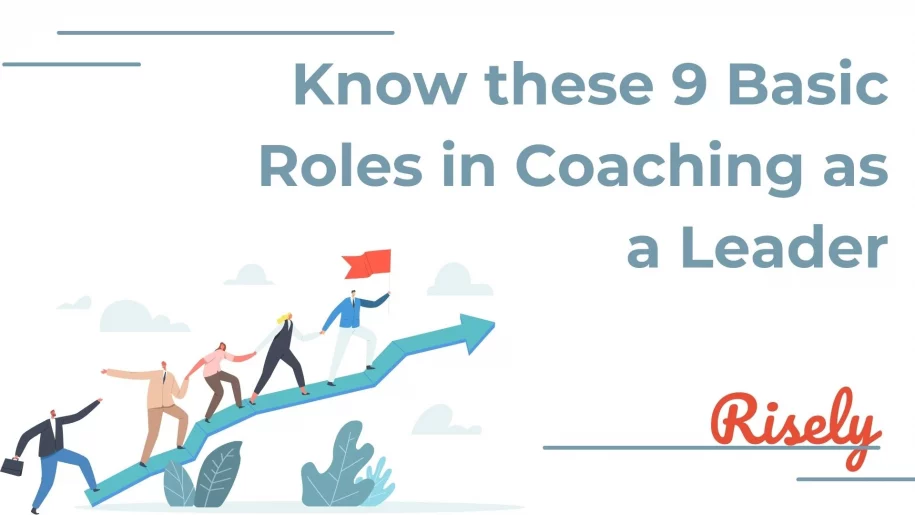Know these 9 Basic Roles in Coaching as a Leader
As an L&D leader, your role isn’t just about guiding your teams; it’s also about spotting underlying issues in team dynamics and knowing which coaching roles are needed to address them effectively. Your expertise lies in not just mastering these roles yourself but also in empowering the team managers to adopt the right role at the right time as the situation demands. By teaching the 9 essential coaching roles, you enable your managers to mentor, motivate, and guide their teams toward success. You will help them grow and develop through participation in such important roles as mentor, facilitator, or strategist. It aids in improving individual and team performances but also empowers people with confidence to unlock their full potential. In this blog, we will consider how, as an L&D leader, you help your team managers adopt the different roles in coaching for specific challenges within your organization and navigate the intricacies of modern leadership in the pursuit of lasting success.Why do we need different Coaching Roles?
In coaching, it is really important to know the different roles involved. This means understanding how coaching has changed in leadership and why these roles matter so much for strong leadership. Each role, such as a mentor, facilitator, or strategist, is key to helping your team’s learning and development. But why is there a need for so many roles? Why can’t coaching be considered as a single role in itself? The answer is simple- Coaching involves different roles because each role addresses specific needs and dynamics within a team, from personal guidance to strategic planning. The view of coaching as one role limits flexibility and effectiveness. Recognizing diverse roles is important to ensure comprehensive support and promote holistic development, addressing diverse aspects in the growth of individuals and teams. Managers or team leads should take on these roles to build a safe space for their team, giving them emotional support and guidance. This understanding helps leaders handle the challenges of coaching well.The Evolution of Coaching in Leadership
The way managers approach their role has changed a lot with coaching. According to Harvard Business Review, companies are also gradually getting away from the “command-and-control” practices and becoming something very different: a model in which managers support and guide, rather than instruct, and employees are offered ways to learn how to adapt to environments that constantly change so fresh energy, innovation, and commitment can be unleashed. The role of the manager, in short, is becoming that of a coach. As an L&D leader, you help managers embrace their roles as coaches, knowing that coaching involves much more than just do’s and don’ts. This approach shows your commitment to your team’s mental health and well-being. You create a safe space where everyone feels comfortable speaking openly and receiving support. As coaching styles evolve, you understand the need to offer both advice and emotional support, guiding your managers towards a more comprehensive approach to leadership development.Why is it Essential for Leaders to Recognize Coaching Roles?
Leaders need to recognize the roles in coaching to help them handle the challenges of leadership better. Knowing the details of each coaching role can really help team performance. It also supports a culture of ongoing growth. When L&D team helps managers take up the different responsibilities of a coach, they can help in making a safe space for all the team members. Here, they can offer guidance and also emotional support. This complete approach not only improves individual growth but it also builds better team dynamics. In the end, this leads to success for the organization. There are different leadership coaching models available to provide a structured approach to coaching and developing leaders and managers in the workplace. Coaching models such as the GROW model is widely used by L&D professionals for personal development and goal setting.The 9 Essential Coaching Roles Every Leader Must Embrace

Mentor: Steer the Team Members Toward Personal and Professional Growth
A mentor guides the coaching conversation by first understanding the team’s needs, ensuring progress toward tangible results and success. This role is crucial for empowering and supporting team members in their learning and development journey. L&D teams should ask managers to step into a mentor role at times when deep, individualized guidance is required for skill-building and personal growth. This role is important in catering to specific developmental needs of team members. For example, you might notice that a member of your team is struggling to learn new software. You, as an L&D professional, would think this might be the perfect opportunity for the manager to take on the role of mentor-where that manager provides one-on-one support, discusses the experiences they have shared with the tool, and shares tips to help the member gain proficiency and become more certain in their own abilities.Facilitator: Towards Greater Team Engagement and Learning
Team leads or managers who act as facilitators have an essential role in engaging their teams and supporting learning. A facilitator creates a safe space where team members can express themselves openly. They encourage everyone to participate and help solve problems together. When managers facilitate well, they improve team dynamics, communication, and speed up skill growth. By guiding discussions and interactions, managers help their teams share ideas and knowledge. This teamwork drives them towards common goals and boosts overall team performance. Say, for instance, if the team is divided on how to approach a major presentation, as an L&D specialist, you can suggest the manager to act as a facilitator. In this role, the manager would guide the discussion, ensuring that all voices are heard, and help the team in reaching a consensus on the best approach.Strategist: Steering the Team Toward Organization Goals
Strategists in coaching are very vital. They play a significant role in helping teams realize big goals set by the organization. They use their knowledge to create plans that connect what each person does to the team’s mission. Spotting important milestones and making a clear way, strategists give teams direction for success. As an L&D leader, you understand the role of a strategist well and realize the situations where this role needs to be applied. You share your insights with team managers, helping them understand and embrace this role themselves. With your guidance, managers learn how to adjust plans based on their teams’ needs, helping everyone adapt and grow. This support allows them to create clear, focused plans and direct their teams toward specific goals, making their approach more strategic and purpose-driven.Consultant: Providing Expertise and Advice When Needed
A consultant is an essential element in coaching. This role brings unique, specific knowledge and guidance that is crucial for team growth. Their skill set helps teams deal with issues and find a clear direction. By giving the right advice, consultants empower team members to make wise decisions, sustaining the team’s win. The role further displays the value of external perspectives on improving performance. This aspect of coaching is a crucial element of sound leadership. As the L&D leader, you need to lead team managers through the process of becoming a consultant for their teams. Imagine a team that has some problems with engagement; you may want to equip the manager with the necessary capability to diagnose the root causes of this issue and provide them with a tailored solution. With the right insight and tools, you are empowering your managers to respond to challenges, provide direction, and make informed decisions.Motivator: Engaging and Energizing the Team
As a motivator, one does much more than motivate their team. Motivators are there to inflame the team’s passions. To do that, they must understand and inspire the team’s dreams and goals. Equally important is having a strongly developed sense of empathy and coaching style. This builds direction and excitement. Most importantly, offering their team a safe space where they feel comfortable sharing their feelings is critical. This emotional support may boost everyone’s motivation. Imagine you, as an L&D head, notice that a project team is struggling with low morale and a lack of enthusiasm, which is affecting their productivity. Recognizing this challenge, you determine that the team manager could address this issue effectively by stepping into the role of a motivator. So, you guide the manager to hold a team meeting to address concerns, appreciate their efforts, and introduce team-building activities or rewards. These actions help boost morale and improve overall performance.Observer: Provide Objective Feedback to Improve Performance
An observer is more than a watcher. A leader, when providing honest feedback, enables people to perform better. This feedback is developmental in nature, not a fault-finding mission. Leaders create an environment where everybody feels safe and comfortable receiving feedback. This motivates everyone to improve constantly. By suggesting the role of an observer, you guide the team manager in uncovering the root causes of the team’s issues and facilitating more effective communication and resolution strategies. This approach helps the team to improve their dynamics and work together more cohesively. As a leader, you can also encourage the team managers to request feedback from their team members to identify any issues as well as for personal improvement.Other Interesting Reads
Counselor: Assisting Team Members in Overcoming Problems
In the course of coaching, a counselor is needed to assist team members in getting out of problems. An excellent L&D leader who recognizes this counselor role will establish a safe space. It is in such a space that team members can be freely supported emotionally and advised. This type of support helps a member clearly express their ideas and feelings. As an L&D specialist, you will know that the role of counselor in keeping good mental health and well-being within a team is not one that can be underestimated. There needs to be some clear direction, but equally, there needs to be empathy and understanding; team members often need to overcome obstacles and seek support. By encouraging managers to put on their counselor hat when appropriate, you help create an atmosphere of care that allows for growth and the establishment of solid, supporting manager-to-team-member relationships. Your guidance is what empowers managers to stand by their teams as they need.Coordinator: Ensuring Smooth Team Operations and Collaboration
Coordination is very important for effective and smooth teamwork. A coordinator brings efforts together significantly, making the process more accessible and productive. They manage how tasks are shared and how communication happens, therefore creating a strong team. A good coordinator will create a safe environment that allows team members to share ideas openly. They build a feeling of belonging and respect. It is only then that, with the support of team members, there are joint efforts towards set goals, hence success and unity in work. As an L&D head, you observe that a project team is struggling with overlapping responsibilities and miscommunication, leading to delays and confusion about who is responsible for what tasks. To address this, you decide that the team manager should take on the role of a coordinator. You guide the team manager in improving coordination within the team, leading to better organization, clearer communication, and enhanced overall productivity.Learner: Continually Gaining New Skills and Knowledge
To excel in different coaching roles, a leader has to become a lifelong learner, inspiring the managers and team leads to do the same. They develop their capacity through the constant pursuit of new skills and knowledge acquisition. This also allows their team to take a growth-oriented approach and develop. While coaching, a learner facilitates flexibility, new ideas, and a deeper understanding of the team’s needs. A person with an attitude of learning, cultivates a culture of curiosity and progress toward long-term success and personal happiness. By suggesting the role of a learner to team managers, you guide them in gaining the knowledge and confidence needed. This approach not only helps the manager become more proficient but also models a positive attitude towards learning for the entire team, facilitating smoother adoption of new tools and enhancing overall productivity.How to Implement Coaching Roles in Various Organizational Contexts?
As an L&D leader, your key job is to turn people managers into effective coaches who get the best out of their teams. This means knowing the different coaching roles and adapting them to suit the special dynamics of various organizational contexts. Each organization has its unique culture, values, and challenges; therefore, coaching roles need to be tailor-made. For example, within a fast-moving startup, encouraging managers to make full use of the “Strategist” role will provide an opportunity to help the teams sail through uncertainty by developing flexible strategies. In contrast, in an organization with a more traditional bent, the role of “Mentor” may be better utilized, focusing on long-term career development and providing structured guidance. However, coaching needs special tailoring for both of these. This ensures that managers adapt to the coaching role that fits the context, which in turn will enhance the growth, engagement, and improvement of teams’ performances.Tailoring Coaching Strategies To Fit Team Dynamics
Coaching works much better once you understand the dynamic of your team and apply your strategies appropriately. As the L&D leader, it will be your responsibility to encourage the team managers to make use of the coaching style according to a team’s development stage or individual preferences. Building rapport and showing empathy, managers open up a line of safe communication with their people. This customized approach, in this respect, enhances the coaching conversations while at the same time greatly enhances team performance and motivation, and also allows all team members to feel appreciated and valued.How Can Multiple Coaching Roles Be Managed Effectively?
As an L&D leader, you can help team managers effectively balance multiple coaching roles by first assessing the team’s unique needs and then guiding the managers to adapt their approach accordingly. For example, you might instruct a manager to take on the role of a mentor when focusing on individual development, switch to a facilitator role during team meetings, and act as a strategist when planning for future goals. By setting clear expectations, maintaining open communication, and encouraging flexibility, you ensure that managers can manage these roles effectively and support their team’s growth and success.Key Performance Indicators for Success in Coaching
- Improved Team Performance: Measurement of progress towards goals and overall productivity.
- Increased Employee Engagement: Tracking changes in team morale and participation levels.
- Enhanced Skill Development: Assessing growth in specific skills or competencies.
- Positive Feedback: Gathering input from team members on coaching effectiveness.
- Achievement of Coaching Goals: Evaluating the completion of set objectives and milestones.
- Retention Rates: Monitoring turnover and retention within the teams.
Developing Your Coaching Skills: A Way Forward
Knowing more than the basics will drastically enhance your coaching efficiency. While coaching skills such as active listening, asking powerful questions, giving and receiving feedback, and empathy are very important, learning will further refine such leadership skills. As an L&D leader, your role is to identify the issues your team faces and suggest the most suitable coaching roles to team managers. It’s crucial to not only recommend these roles but also explain how they work and how they can address specific challenges. By staying updated with the latest trends and techniques in coaching, you’ll be better equipped to guide managers in implementing these roles effectively, ultimately providing the best support and fostering your team’s growth.Conclusion
In conclusion, a leader desiring to grow and develop their teams ought to know the different roles that coaching takes. In a safe environment, a leader creates space for team members by taking up various tasks: mentoring, guiding, advising, and the like. Developing a coaching style that includes empathy, clarity, and emotional support is essential. This will help each person reach their full potential. Keeping coaching sharp and changing strategies to fit the needs of the team will bring about successful leadership.Start coaching your team with a helping hand from Risely.
Grab free resources like our GROW coaching worksheet to make your coaching sessions smooth and successful.
Building a Coaching Culture with Jo Wright
Building a Coaching Culture with Jo Wright As AI takes over, we are all searching for the part that makes…
What is Immersive Learning? A New Era in Education
In this blog, you’ll learn what is immersive learning and how it is changing training, increasing engagement, and influencing the…
The Clear Coaching Models: A Revolutionary Approach to Coaching
This blog delves into the principles, significance, and applications of the CLEAR coaching models, exploring how they transform organizational development…
Drive Meaningful Growth With The STAR Coaching Model
In this blog, we will explore the key elements of the STAR coaching model, outline effective implementation strategies, and discover…
The OSKAR Coaching Model: Proven Techniques For Lasting Impact
In this blog, we’ll explore the key elements of the OSKAR model, its benefits, and how to implement it to…


